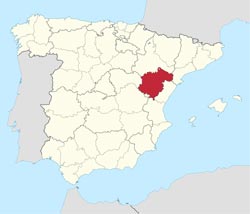Teruel in Teruel

The province of Teruel, situated in northeastern Spain in the Aragon region, has the second lowest population density in Spain: a scarce 9.01 inhabitants per km2. It covers a surface of 14,809 km2 and has a population of 134,176 souls.
Neither the capital of the same name or any of the other municipalities in the province have a population of more than 50,000 inhabitants. The province borders on fellow Aragon province Zaragoza to the northeast, north and northwest. It furthermore shares boundaries with the provinces of Tarragona, Castellon, Valencia, Cuenca, and Guadalajara. Teruel is a province crisscrossed by mountain ranges and the average height is 1,058.9748 MASL. The highest point is the peak of Peñarroya in the Iberic System at 2028 MASL. The lowest point is in Castelnou, at 201 MASL.
 Five of Spain’s ten highest villages are situated in Teruel. Due to its height and the mountain systems that shields it from Mediterranean weather, Teruel gets very cold in winter. The average minimum temperature for all year round is 6.2ºC, the maximum 21.5C. The lowest temperature ever registered there was -19ºC on Boxing Day 2001.
Five of Spain’s ten highest villages are situated in Teruel. Due to its height and the mountain systems that shields it from Mediterranean weather, Teruel gets very cold in winter. The average minimum temperature for all year round is 6.2ºC, the maximum 21.5C. The lowest temperature ever registered there was -19ºC on Boxing Day 2001.
The capital of Teruel is Teruel in the south of the province. It is situated at a height of 915 MASL and has a population of 36,240, which makes it Spain’s least populated capital. Apart from its harsh climate, Teruel is famous for its Serrano hams, pottery and its Mudejar artistic heritance, which has been declared World Heritage by the Unesco.
The Catedral de Santa María de Mediavilla is one of the most characteristic Mudejar constructions in Spain and one of very few cathedrals constructed in this style. The site of Teruel has been inhabited since time immemorial, but the first historical records of the city show that Alfonso II of Aragon occupied the lands in the area and founded the city. According to legend, the king was looking for the ideal site to put the founding stone of the city when he saw a bull on a hilltop under a shining star. The king took this as a sign, started the city on that spot, and the bull and the star became, and still are, the symbol and shield of the city
It was not easy to populate the city, which was on the border of the Muslim taifa of Valencia, and the king had to offer serious privileges to persuade people to settle there. The city grew slowly over the next couple of centuries until it reached the impressive number of 6,000 inhabitants. Sadly, the plague took a serious toll on Teruel as well as on many other Medieval cities all over Europe and initiated a seriously economic and demographic decline.
The economic decline was not helped by the Inquisition which castigated the Jews – the most industrious and financially capable community of the city. For this reason, the general population tried to resist the Inquisition, but the Church prevailed and clamped down as hard in Teruel as everywhere else.
A sad claim to fame for Teruel is that one of the bloodiest of the battles of the Civil War was fought there. It was fought from 15th December 1937 to 22nd February 1938 and cost the lives of 97,000 solders on both sides. The Civil War left deep scars, material and emotional, on both sides which took several decades to heal, but Teruel has risen from the ashes and is today a bustling little city whose economy is dominated by the services sector, especially the public sector and tourism. The latter has been on the rise ever since the nineteen nineties, and Teruel has become a sought-after destination for cultural and other inland tourists.


